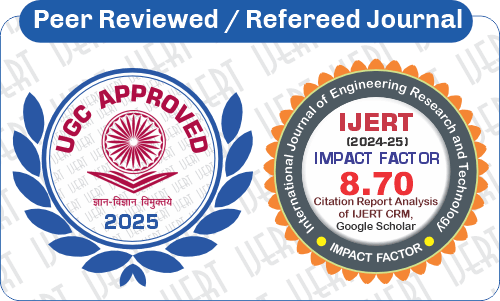 DOI : 10.17577/IJERTV14IS030212
DOI : 10.17577/IJERTV14IS030212

- Open Access

- Authors : Abhinaya Pk, Adhya Cb, Mayoora Kc, Soorya Prakash, Adwaith R, Rishin Chandran, Aadithyan, Aswathi R
- Paper ID : IJERTV14IS030212
- Volume & Issue : Volume 14, Issue 03 (March 2025)
- Published (First Online): 16-04-2025
- ISSN (Online) : 2278-0181
- Publisher Name : IJERT
- License:
 This work is licensed under a Creative Commons Attribution 4.0 International License
This work is licensed under a Creative Commons Attribution 4.0 International License
Waste Water Purification using Phytorid Technology
Abhinaya Pk, Adhya Cb, Mayoora Kc, Soorya Prakash, Adwaith R, Rishin Chandran, Aadithyan
Diploma students Department of Technical Education
Government Polytechnic College Mattannur, Department of Civil Engineering,
Kannur, Kerala, India.
Abstract In developing countries the usage of water source plays a vital role and its been needed and used in large amount. Contamination of water by toxic pollutants through the discharge of municipal, domestic and industrial wastewater has become a worldwide environmental problem due to its serious consequence on human health, agricultural crop productivity and aquatic ecosystem. Phytorid technology has become a logical solution to improve the quality of contaminated water by acting as a sink for various contaminants. Phytorid technology is a subsurface flow type where water is applied to the beds filled with porous media such as gravel and stones. Our research focused on the combined effect ofphytorid technology and coco-husk in waste water purification system. Here the coco-husk is used as a filter media. The coco-husk is help to improve COD level and other parameters. We developed a small-scale phytorid tank to purify wastewater for domestic use. It is purposed to clean domestic waste water economically. We found that the combination of phytorid and coco-husk as a filter media effectively purifies waste. Phytorid treatment removes most pollutant naturally and filtration refine the quality further, producing clean reusable water. Phytorid technology seems to be more economical, less area consuming, easy maintenance, sustainable and energy efficient. Studies on phytorid technology using coco husk is less. This study focuses more on coco husk and its filtration abilities in combination with phytorid treatment techniques.
KeywordsPhytorid technology; waste water purification; coco- husk
Aswathi R
Guest Lecturer In Civil Engineering Department of Technical Education Government Polytechnic College Mattannur.
Kannur, Kerala, India
This necessitates use of natural methods, which are highly efficient and structured. Using this concept, natural wetland functioning has been used to design a technology wherein wetlands plants and combined working of their root system have been integrated to get a designer ecosystem. National Environmental Engineering Research Institute (NEERI) has developed a novel technology based on natural method of treatment of sewage using constructed wetlands. The technology is named as PHYTORID and is well patented nationally and internationally.
Phytorid technology, also known as phyto remediation, is a cost-effective and eco-friendly approach to cleaning up contaminated soil, water, and air. This innovative technology utilizes plants and their associated microorganisms to remove, degrade, or immobilize pollutants, such as heavy metals, pesticides, and industrial contaminants. By leveraging the natural processes of plant growth and microbial activity, Phytorid technology can effectively restore contaminated environments, improve water quality, and promote sustainable ecosystem development. Additionally, Phytorid technology offers a range of benefits, including low operational costs, minimal environmental disruption, and the potential for habitat restoration and biodiversity conservation.
-
MATERIALS AND METHODS
-
INTRODUCTION .
This In the developing countries the usage of water source plays a vital role and its been needed and used in large amount. Contamination of water by toxic pollutants through the discharge of municipal, domestic and industrial wastewater has become a worldwide environmental problem due to its serious consequence on human health, agricultural crop productivity and aquatic ecosystem.
Untreated wastewater is sometimes dumped on the agricultural fields, ponds, river, and domestic and industrial places .in order to make the method feasible selection of technology for waste water treatment should be on criteria such as plant which works without electricity, require minimum maintenance and most importantly, the technology should be self-sustainable. In order to use the technology in domestic and rural areas these criteria become more important due to lack of skilled manpower and challenges in electricity, cost etc.
-
Material properties
Phytorid technology is consist of sedimentation tank, phytorid bed, and collecting tank. The phytorid bed consist of four layers, for the layers we used the materials such as sand, cocohusk, gravel. Each layer is consisting of a definite size and each component has its own role in the phytorid technology.
-
Sand.
Sand is a filter media used to remove suspended solids, floating particles, and sinkable particles from water. It's used in water treatment plants, households, and industrial settings. The sand has granular structure provides a large area of capturing suspended particles in water as it flows through, effectively removing sediment and pollutants by trapping them between the individual sand grains. The properties of sand are showing in table 1 and Fig 1 shows the sample sand
-
Coco Husk
TABLE 3: Properties of gravel
Test on sand
Sieve analysis
Particle size
Below 1.18
Porosity
30% and 65%
Fineness modules
2.8
Uniformity coefficient
2.1
Water absorption
2-3%
Fig 1: Sand
facilitating their removal. The open structure of gravel allows for efficient water flow, preventing clogging and ensuring consistent filtration. The properties of gravel are showing in table 3 and Fig 3 shows the gravel material
TABLE 3: Properties of gravel
Test
Sieve analysis
Particle size
26,20,12,10,4.75 mm
porosity
20% to 40%
Fineness modulus
6 to 8.5
Uniformity coefficient
Greater than 4
Water absorption
Very low
Coconut husk, particularly coconut husk fragments, serves as an effective and sustainable filter media due to its natural structure, high absorption capacity, and mechanical resistance, making it suitable for wastewater treatment and other
d) Phyto rid Plant.
Fig 3: Gravels
filtration applications. Coconut husk is a readily available, renewable, and biodegradable by product of coconut processing, making it an environmentally friendly option. Coconut husk fragments are used in wastewater treatment systems, including anaerobic filters, to remove organic matter and other pollutants.
The properties of coco-husk are showing in table 2 and Fig 2 shows the coco-husk
TABLE 2: Properties of coco-husk
Test
Water absorption test
Porosity
22% and 30%
Water absorption
Up to 83%
In Phyto rid technology, wetland plants play a crucial role in wastewater treatment by directly or indirectly removing pollutants through mechanisms like phytodegradation, phytodegradation, and phytovolatilization, while aso providing a habitat for beneficial microorganisms. It offering a cost-effective and environmentally friendly alternative to traditional waste treatment. Phyto rid plants, particularly those with extensive root systems, can directly absorb pollutants from the wastewater, such as heavy metals, nutrients (nitrates, phosphates), and organic matter. Wetland plants provide a large surface area for microbial attachment and growth, which is crucial for the biological processes involved in wastewater treatment. The physical structure of the plants helps to slow down water flow, allowing for the settling of suspended solids and improving water clarity. Plants transport oxygen from the atmosphere to the roots and surrounding soil, creating an aerobic environment that supports beneficial microbial activity. The Fig 4 shows the phytorid plant (canna)
Fig 2: coco-husk
-
Gravel.
Gravel is a crucial filter media in water filtration systems, acting as a mechanical filter and support layer, trapping larger particles and pollutants, and preventing clogging,
-
-
Treatment process.
Fig 4: Canna plant
while also improving overall water flow and system longevity. Gravel serves as a stable support layer for finer filter media like sand, preventing compaction and maintaining the integrity of the filtration bed. He irregular shapes and sizes of gravel particles increase the surface area within the filter bed, allowing pollutants like bacteria, viruses, and organic waste to cling and accumulate,
Phyto rid technology is a subsurface flow constructed wetland system (SSFCW) designed to treat wastewater, particularly sewage, using natural processes like filtration, sedimentation, and nutrient uptake by plants and microbes.
-
Sedimentation.
Plain sedimentation is the process of removing suspended matter from the water by storing it in tanks. All the suspended matters settle down and they can be filtered. Plain sedimentation is a water treatment process that uses gravity to remove suspended solids and some biological contaminants from water by allowing it to settle in quiescent tanks, without the addition of chemicals. In plain sedimentation, water is held in a tank or basin, allowing heavier particles to settle to the bottom under the force of gravity. Plain sedimentation is not effective at removing very small particles or those that are not dense enough to settle quickly. It's also not very effective at reducing microbial contamination.
-
Filtration.
Filtration is a process that separates solid particles from a liquid or gas by passing the fluid through a porous medium (the filter) that retains the particles. The principle is that substances with particle sizes larger than the pore size of the filter are retained, while the rest of the fluid passes through. Filtration can be a physical, biological, or chemical operation. Filtration removes a wide range of contaminants, including suspended solids, turbidity, bacteria, viruses, and other undesirable substances. By removing these contaminants, filtration significantly improves the clarity, taste, and safety of water. Filtration is a vital step in producing safe drinking water, protecting public health.
-
Phyto rid bed.
The Phyto rid bed consist of Phyto rid plant, soil, sand, coco- husk and gravels. The sand act as a filter media these helps to trap contaminations in the waste water, and the coco husk also act as a filter media and the gravel act as a support media, these gravels support the filter media and helps to improve water quality. The phytorid plant has mass roots these helps to absorb nutrients from the waste water. In the phytorid technology the phytorid bed is important part. These phytorid bed is help to clean the waste water.
-
-
Collection of material. After the treatment collect the treated water to a tank, and use the water for various purposes like irrigation, bathing, washing etc. This treated water, aimed for human consumption or specific uses, should be tasteless, odorless, colorless, clear, and free of harmful microorganisms and suspended impurities.
-
-
-
TEST ANALYSIS OF WASTE WATER BEFORE AND AFTER
The performance of the waste water and treated water is obtained by undergoing series of tests in different parameters and analyzing the test result of water before and after. In this phytorid technology is carried out by the parameters of BOD, COD, DO, alkalinity, acidity, pH, turbidity, odour, chloride etc.
-
Biological oxygen demand (BOD).
Biological Oxygen Demand (BOD) measures the amount of dissolved oxygen needed by microorganisms to break down organic matter in a water sample, serving as an indicator of water quality and pollution levels. A BOD test measures the
amount of oxygen consumed by microorganisms during a specific period (often 5 days at 20°C)
-
Chemical oxygen demand (COD).
COD test determine the oxygen required for chemical oxidation of organic matter with the help of strong chemical oxidant. The organic matter gets oxidized completely by potassium dichromate in the presence of sulphuric acid to produce Co2 +H20. The excess K2Cr2O7 remaining after the reaction is titrated with Ferrous Ammonium sulphate. The dichromate consumed gives the oxygen required for oxidation of the organic matter.
-
Dissolved oxygen (DO).
Oxygen dissolved in water, often referred to as DO, is a very important parameter of water quality and is an index of physical and biological process going on in water. There are two main sources of dissolved oxygen in water i) Diffusion from air ii) Photosynthetic activity within water. Diffusion of oxygen from air to water is physical phenomenon and depends upon solubility oxygen, which in turn, is influenced by factors like temperature, water movement, salinity etc.
-
Chloride.
If water containing chlorides is titrated with silver nitrate solution, chlorides are precipitated as white silver chloride. Potassium chromate is used as indicator, which supplies chromate ions. As the concentration of chloride ions approaches extinction, silver ion concentration increases to a level at which reddish brown precipitate of silver chromate is formed indicating the end point.
-
pH.
The pH is a negative logarithm of the reciprocal of hydrogen ion concentration. The pH scale is used to express the degree of acidity or alkalinity with the middle value (pH) corresponds to the exact neutrality at 250C.
-
Turbidity.
When light is passed through a sample having suspended particles, some of the light is scattered by the particles. The scattering of the light; or absorption of light is generally pro proportional to the turbidity. The turbidity of the sample is thus measured from the amount of light scattered by the sample taking a reference with standard turbidity suspension.
-
Odour.
To determine the odor of wastewater, you can use the Threshold Odour Number (TON), which represents the dilution ratio at which the odor is just detectable, measured using an instrument called an olfactometer.
-
Hardness.
Water hardness, primarily caused by calcium and magnesium ions, is commonly tested using methods like titration with EDTA, colorimetric analysis, or simple soap tests
-
-
RESULT AND DISCUSSION
-
The analyze the effectiveness of the waste water treatment process, we compare three stages, raw water (before treatment) waste water after phytorid treatment (natural plant- based treatment) and water after filtration (final purification step).
-
PURPOSED TANK FOR DOMESTIC WASTE
-
WATER TREATMENT
TABLE 3: Test analysis of waste water
|
Sl No |
Param eter |
Initial Value |
phytor id plant |
Final Value |
Removal Efficiency |
Remarks |
|
1 |
pH |
7.9 |
7.5 |
7.2 |
– |
Permissible (6.5- 8.5 As Per B.I.S) |
|
2 |
Turbid ity |
27.1 |
12.6 |
0.7 |
74.16 |
Permissible (5 NTU As Per B.I.S) |
|
3 |
Hardne ss |
245.6 |
202.3 |
161.3 |
34.32 |
Permissible (300mg/L AS PER B.I.S) |
|
4 |
Chlori de |
635.3 |
356.2 |
151.4 |
76.16 |
Permissible for irrigation (250mg/L AS PER B.I.S) |
|
5 |
Dissol ved Oxyge n |
2.8 |
4.7 |
5.8 |
– |
Permissible (>6mg/L AS PER B.I.S) |
|
6 |
BOD |
102 |
12.3 |
3.2 |
96.86 |
Permissible (30 Mg/L As per environmental standards) |
|
7 |
COD |
536 |
97.89 |
48 |
85.28 |
Permissible (250 mg/L as per environmental standards) |
|
8 |
0dour |
Disagr eeable |
disagre eable |
Agreea ble |
– |
Agreeable |
Fig 4: Purposed tank
-
It is a small-scale tank for domestic waste water purification.
-
This tank is based on the phytorid technology method.
-
It consists of four layers of boxes with handles.
-
We provided the handles to facilitate easy cleaning of materials.
-
In the table 4 we can see the test analysis of the parameters such as pH, Turbidity, Hardness, Chloride, DO, BOD, COD.
-
We can see that significant reduction of cod, bod, chloride, turbidity and hardness at different stages.
-
The COD and BOD have removal efficiencies of 85.28% and 96.86% respectively.
-
The parameters such as pH, odour and do have improved significantly.
-
The combination of phytorid and coco husk as a filter media effectively purifies waste water to meet environmental and domestic use. Phytorid treatment removes most pollutant naturally and filtration refine the quality further, producing clean reusable water.
-
This combined approach ensures safe water discharge or reuse for irrigation and domestic application.
CONCLUSION
Based on the above analysis, it can be concluded that
-
treated water can be used for various purposes, such as gardening, flush tanks, irrigation, and cleaning.
-
In developing countries, due to various investment priorities, implementing high-cost wastewater treatment technology on a large scale may not be feasible.
-
Therefore, this technology could be an alternative for wastewater treatment in a sustainable manner.
-
It is a suitable option for small-scale domestic wastewater treatment.
-
REFERENCE
-
Divyesh Parde a et al, A review of constructed wetland on type, treatment and technology of wastewater, Science direct volume 21 February 2021, 101261.
-
Nicola Brown et al., Brown coconut husks as media within an anaerobic filter for improving on site wastewater treatment ( MDPI applied science 2025,15,,1944)
-
Ankur petkar et al, Treatment of sewage &industrial waste water by using phytorid technology, International journal for modern trends in science and technology 2022 , 8(05),pp.58-68.
-
Harsh Kumar Saimar et al , Comparative analysis of rootzone treatment (phytorid technology) in domestic sewage treatment system – (IRJET 2023 ISO 9001:2008 journal .
-
Ashlesha chapole et al, Studied the phytorid waste water treatment technology, IRJMETS, volume 4, issue 05, may 2022.




